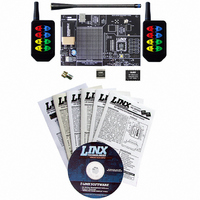MDEV-418-HH-LR8-MS Linx Technologies Inc, MDEV-418-HH-LR8-MS Datasheet - Page 3

MDEV-418-HH-LR8-MS
Manufacturer Part Number
MDEV-418-HH-LR8-MS
Description
KIT DEV MS HANDHELD TX 418MHZ
Manufacturer
Linx Technologies Inc
Series
MSr
Type
Transmitterr
Datasheet
1.MDEV-418-HH-LR8-MS.pdf
(7 pages)
Specifications of MDEV-418-HH-LR8-MS
Frequency
418MHz
Product
RF Development Tools
Maximum Frequency
418 MHz
Supply Voltage (max)
9 V
Lead Free Status / RoHS Status
Contains lead / RoHS non-compliant
For Use With/related Products
MS Long Range Handheld Series - 418MHz
Lead Free Status / Rohs Status
Lead free / RoHS Compliant
SETTING THE TRANSMITTER ADDRESS
OTX-***-HH-LR8-MS BUTTON ASSIGNMENTS
Figure 3: OTX-***-HH-LR8-MS Button Assignments
Page 4
The
Transmitter allows the selection of one
of 16,777,216 (2
All transmitters are supplied set to the
same address. To avoid contention with
other
relationships, the address can be
changed. This is accomplished by using
a paper clip or probe to press the
CREATE button on the board through
the hole in the back of the case. Press
the button and a LED will light up in the
MODE_IND window, indicating that the
address is being created. The address will be randomized for as long as the
button is held down. Release the button and the randomized address will be
saved and the LED will begin flashing to indicate that the Control Permissions
may now be set. Press the buttons that the transmitter will have the authority to
access. Press the CREATE button with the paper clip again or wait 17 seconds
for it to time out. The address and Control Permissions are now set. The decoder
will need to learn the address before it will accept any transmissions. Please see
the Typical Applications section of this data guide or the MS Series Decoder
Data Guide for details.
This diagram illustrates the relationship between the button locations and
encoder data lines.
MS
units
Long-Range
or
24
) unique addresses.
to
create
Handheld
D6
D4
D2
D0
unique
D7
D5
D3
D1
Figure 2: CREATE Button Access
MODE_IND Window
CREATE Button
THE DECODER BOARD
Figure 4: The Decoder Board RF Area
The Prototyping Area
The Power Supply
The RF Area
The decoder board included with the evaluation kit uses an LR Series receiver
to receive the signal from the Handheld transmitter and then feeds it into an MS
Series decoder. The board is designed to allow full access to the many features
of the decoder and to speed development and integration of the LR and MS into
a product. The following sections describe the features of this board in detail.
The prototyping area on the decoder board contains a large section of plated
through-holes so that external circuitry can be placed on the board. This circuitry
can be interfaced with the MS Series decoder through the breakout header to the
right of the holes. At the bottom of this area is a row connected to the 3V power
supply and at the top is a row connected to ground.
All of the data lines are connected to a wire-wrap header to the right, allowing
easy access from the prototyping area. The Decoder Data and TX ID lines are
also available on the header as well as the PDN line from the RF module. This
allows complete control of the entire system from the prototyping area, giving the
designer a great deal of flexibility in using the board.
The power supply on the decoder board consists of a standard 9V battery and
power jack connected to a 3.0V voltage regulator. It can provide approximately
500mA of current to the prototyping area. If the added circuitry will need more
than this, the designer must add an external supply. If the circuit will consistently
draw more than 100mA of current, it might be better to use the power jack rather
than the battery, as the battery may run down fairly quickly, reducing testing and
development time.
The jack accepts a standard 5.5mm plug with the tip ground and the outer shell
7 to 16VDC positive supply. While a reverse voltage protection diode has been
included on the board to protect the circuitry in case the voltage on the plug is
reversed, it is still a good idea to double-check the polarity.
The figure below shows the RF area of the development board. The board uses
the LR Series receiver as shown. Attach the included antenna to the reverse
polarity SMA connector before operation.
Page 5

















